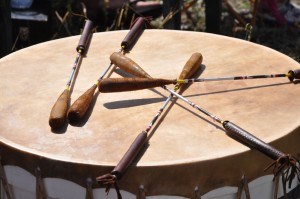
In Grade 7, students learn about Canada’s origins and the movement of people throughout our vast country, leading up to and after confederation.
They also learn about Canada’s Aboriginal people and the role they played in Canada’s formation.
To bring that history to life and to connect the region’s youth to its importance, Parks Canada is in the process of creating a brand new Aboriginal education program to be offered at the Palisades Stewardship Education Centre.
The program is titled “Teachings of the Mountain People” and has seven units that look at everything from homesteading to traditional ecological knowledge, like the medicinal properties of plants.
Involved in the program’s creation are members of the Aseniwuche Winewak Nation (AWN), Upper Athabasca Valley Elders Council and Kelly Lake Métis, three groups with historic ties to the Jasper Valley.
Before Jasper National Park was formed in 1907, the area was home to 20 to 25 Aboriginal groups that for centuries travelled through the valley, living off the land as hunters, gathers, trappers and guides.
Those people were extirpated after the park’s formation because their traditional way of life conflicted with the government’s vision of national parks as wildlife sanctuaries.
It has taken more than a century for Parks to work toward reconciliation with the various groups who were displaced, and the agency continues to work toward that goal today.
As part of that effort, in 2012, Parks initiated a large-scale project to enhance its relationship with the Métis groups that have connections to Jasper. The project is called Changing Relationships: People of the Upper Athabasca Valley.
“Those people, Metis people and Mountain people, have a long standing connection to Jasper,” said Sherrill Meropoulis, Parks’ Aboriginal liaison officer. “So we met with them to identify and discuss some potential initiatives for this broader project and the development of teaching modules was identified as one of the priorities.
“They wanted to advance teaching stories and understandings of the people who are connected to the landscape of Jasper National Park.”
That education is important, said Brenda Holder, a traditional Métis educator involved in the development of the program, because many of those stories are being forgotten.
“There are a lot of struggles within the Aboriginal community, even now, where we feel excluded,” she said. “Although Parks Canada has been very careful in their verbiage, there’s still people that will say certain explorers discovered this particular place, but they forget that even David Thompson had one of my relatives, Thomas the Iroquois, that showed him how to get over the Athabasca Pass; people forget that.
“They forget that it’s not those explorers that did it on their own, that there is a past there and the reason why many of those explorers were able to do what they did was because our people had an intimate knowledge of the entire landscape, long before Jasper was ever Jasper.
“For me, that’s one of the reasons that I feel it’s really quite critical that these stories get told, that people don’t forget us and leave us behind.”
Holder said the creation of “Teachings of the Mountain People” is an important step in ensuring her people and her history are remembered and honoured.
To create the program, Parks hired Lisa Shepherd, a Métis contractor with ancestral ties to one of Jasper’s early homesteading families, and tasked her with conducting interviews with members of the three Aboriginal groups involved with the project, gathering traditional and historical knowledge.
For instance, Holder provided insight into the process of tanning hides, making pemican, using hoops and arrows and creating wikiup shelters.
And Gary MacDonald, of the AWN, provided traditional knowledge on plants, even taking the time to teach the staff at the Palisades to make “Indian ice cream,” a treat made by mashing and vigorously stirring buffalo berries with a stick until they foam up into a cream.
MacDonald said being able to provide that hands on education to Parks’ staff was important for the authenticity of the program.
“I think they’ll have a better understanding why things were done the way they were done,” he said. “And for the students, I think it’s really good. Instead of somebody just talking about it or reading about it, I think what they’re doing is a good thing, with the kids actually going out in the field and having demonstrations.”
Reflecting on the program, Holder said, “I think that it’s going to be something that will really enhance the school experience for the kids and you never know, it may turn a few of them into archeologists or anthropologists or ethnobotanists, who knows what will be produced out of that.”
The program is now in the hands of the staff at the Palisades Stewardship Education Centre.
“It’s a work in progress,” said Meropoulis, adding that it’s a pilot project, so there will likely be changes made over time, as the educational units are refined and perfected.
As well as being offered as a three-day program with seven units spanning from the history of the fur trade to Aboriginal cultural protocols, the Palisades also plans to offer the units separately, allowing teachers to select the unit they feel best suits their class.
The teacher can then add that unit to another program being offered at the centre.
“So basically a teacher would call me,” explained Barb Schmidt, educational liaison, “and talk about the class they’re bringing, talk about the courses they teach and about what the needs are and then we would tailor a program based on what we already have as existing programs.
“I think Mountain Peoples is going to be a very appealing program for teachers because it has been developed with such care.”
Nicole Veerman
[email protected]
